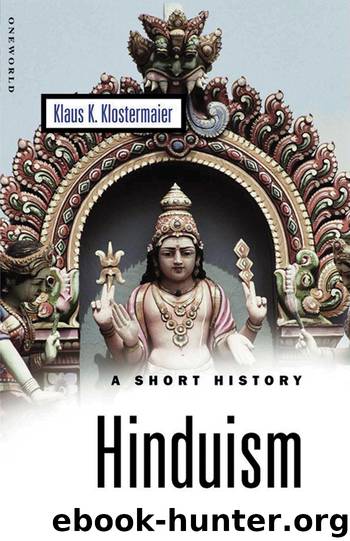Hinduism by Klaus K. Klostermaier

Author:Klaus K. Klostermaier
Language: eng
Format: epub
ISBN: 9781780746807
Publisher: Oneworld Publications
ŚIVA IMAGES AND WORSHIP
Śiva worship has been associated with the people of the Indus Civilization. Besides the images on soap stone seals interpreted as Paśupati and Śiva the Hunter, many phallic emblems have been found. The liṅga has been the most universal form in which Śiva has been worshiped throughout the ages. In Vedic times Śiva-Rudra had been an apotropaic god: his name was not even to be mentioned in order to prevent him from coming, far less would people have wanted his image. The liṅga, now closely associated with Śaivism, had been an old symbol of fertility and immortality and was therefore planted on graves and cremation grounds. It is found not only among high cultures but also among tribal ones.117
From the third and second centuries B.C.E. we have indigenous coins with both phallic and anthropomorphic representations of Śiva. In later times the form of the liṅga becomes more stylized and less realistic, but there are exceptions. One of the earliest sculptures is the liṅga of Gudimallam in South India, still worshiped by Śaivites and considered to date from the second century B.C.E. In the Gupta period so-called mukhaliṅgas become frequent: liṅgas whose top-portions show one or more heads, very often the famous Sada-Śiva combination of Sadyotjata, Vāmadeva, Aghora, Tatpuruṣa, and Iśāna, the Pañcabrahmaśivavatāras of the Śiva Purāṇa. Though the artistic possibilities in representing the Sivz-liṅga are limited, its importance far surpasses that of any other form of Śiva representation. After the consecration (in case it is a human-made liṅga), it is considered to be the salvific presence of Śiva. The myth of Śivalingodbhava, also represented in sculptures, in which Śiva in a human form comes out from the Imga’s opening sides, is meant to underline the real presence of Śiva in his symbol.118 The Śaiva Purāṇas contain many narrations of the salvific effect of the worship of the liṅga, which according to some, are the safest way to attain mukti. Śaivas today see in the Śiva-liṅga an “abstract image” of Śiva, that is, a symbol of Śiva’s formlessness.119
The cult-image in the garbha-gṛha of Śiva temples is usually a Śiva-liṅga, not an anthropomorphic figure. Yet anthropomorphic images are important, as the great number and sublime art of many Śiva representations prove. A well-known system divides them into twenty-five līlā-mūrtis, perhaps in line with the twenty-five tattvas of Śaiva Siddhānta.120
Most of the Śiva images are of the sthāna and āsana type, either Śiva alone (Candraśekhara), or with Umā (Umāsahitā), or with Umā and Skanda (Somaskanda). Śayaṇamūrtis of Śiva are not known except in the Śiva-Sāva images which belong to the Śāktas.
Nandi, Śiva’s vāhana and symbol, is often represented by himself, and sometimes Śiva and Pārvatī are shown seated on him. Kārttikeya, also a savior connected with Śiva, usually appears seated on a peacock. A local variety of Śiva worshiped in Mahārāṣhṭra is Kaithaba.
Among the anthropomorphic images of Śiva we can distinguish two basic types: ugra (ghora) and saumya (śānta) images. Both types are found in many forms. The ugra-mūrtis generally
Download
This site does not store any files on its server. We only index and link to content provided by other sites. Please contact the content providers to delete copyright contents if any and email us, we'll remove relevant links or contents immediately.
Fingersmith by Sarah Waters(2406)
Kundalini by Gopi Krishna(2094)
Wheels of Life by Anodea Judith(1922)
The Bhagavad Gita by Bibek Debroy(1867)
Indian Mythology by Devdutt Pattanaik(1856)
The Yoga of Jesus: Understanding the Hidden Teachings of the Gospels by Paramahansa Yogananda(1752)
Autobiography of a Yogi (Complete Edition) by Yogananda Paramahansa(1739)
The Man from the Egg by Sudha Murty(1683)
Chakra Mantra Magick by Kadmon Baal(1588)
The Book of Secrets: 112 Meditations to Discover the Mystery Within by Osho(1588)
The Sparsholt Affair by Alan Hollinghurst(1509)
Avatar of Night by Tal Brooke(1451)
Sparks of Divinity by B. K. S. Iyengar(1450)
Karma-Yoga and Bhakti-Yoga by Swami Vivekananda(1437)
Gandhi by Ramachandra Guha(1435)
The Bhagavad Gita (Classics of Indian Spirituality) by Eknath Easwaran(1418)
The Spiritual Teaching of Ramana Maharshi by Ramana Maharshi(1373)
Hinduism: A Very Short Introduction (Very Short Introductions) by Knott Kim(1314)
Skanda Purana (Great Epics of India: Puranas Book 13) by Bibek Debroy & Dipavali Debroy(1308)
